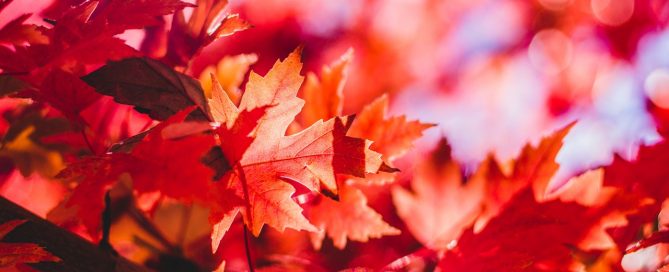Some Like It Hot: Enjoying Red Fall Foliage at Home
When the weather gets cool, some really like it hot…fiery red hot, that is. The heat we’re talking about is blazing red foliage — bursts of color that some find ease the pain of the outdoor season coming to an end.
More than that, say experts, the color red goes beyond sensual pleasure. It stimulates the human system — even increasing pulse and heart rates. It’s well worth it then to be able to enjoy autumn’s bursts of fiery red daily, by having the right trees in your yard.
That said, brilliant red foliage outside our very own windows requires planning. To get all the dirt on what trees to plant, we spoke with Angelo Puleo, Nursery Division at Bissett Nursery (Holtsville, NY).
Maple Trees
“One of the most popular and widespread deciduous trees that produces bright reds in autumn is the beautiful Maple tree,” says Pueleo. “In particular, along with oaks, we recommend Sugar Maples for great fall red color.”
Note: Be sure to ask experts at an established nursery or landscaping firm which variety of maple, etc. will produce red leaves in fall, as some varieties offer up a blazing yellow instead. Not that there’s anything wrong with that…it’s just for another blog post.
A beautiful shade tree in summer with brilliant color in autumn, the Red Maple can be planted any time of year, including fall.
Cleveland Select Pear
Puleo also recommends the Cleveland Select Pear for robust color. Like the Oak and Maple, it is also hardy and can withstand most winds and storms, including ice storms — a real plus in our neck of the woods (the Northeast).
“In spring, the Cleveland Select Pear bursts awake in beautiful white flowers, and in the fall, its leaves offer up a deep orangey-red blaze of color,” adds Pueleo.
A close cousin of the Cleveland Select Pear, the Bradford is pictured here as its leaves begin to turn from green to fall-red.
Japanese Maple
When it comes to smaller trees, Deck and Patio designers often consider Japanese Maples in landscaping plans; red-leafed versions of this beautiful tree offer degrees of red from spring through fall (see last photo). Planting them in early fall allows for new root growth in time for spring.
This beautiful Japanese Maple is native to Japan and other nearby Asian countries such as South Korea. It’s prized for the shape of its leaves and rich red color. It’s useful to note that there are different types of Japanese maples. Some stay red ’til their leaves drop in autumn but others leaf out in brilliant reds in spring and turn to yellows and orange in fall. These, of course, can be dazzling, too, but be sure you get what you want.
Mighty Oaks
In 2004, the gorgeous and majestic oak tree was designated the USA’s official national tree. Known for its wonderful shade and lumber it grows to great heights from just an acorn. You can begin from a seed, but you might also want to transplant one that is partially grown. While you can transplant up to between 5 and 8 feet in growth, it’s best to go with a smaller tree to allow its roots to cope in the process.
A few varieties of oak grow rapidly (e.g., Heritage Oak, Swamp White Oak and Northern Red Oak), making them an ideal choice. Like all the trees mentioned in this blog post, leave about 10 feet between each one when planting. The oaks are sun lovers so choose a sunny spot. Note: For those who keep horses, the oak’s acorn and leaves can be toxic to animals such as horses.
This is by no means an exhaustive list for fiery red foliage. But we hope it’ll be enough to get your heart pumping every time you walk outdoors next fall. The fiery red scene will so take you away that you’ll forget you’re wearing a jacket.




























